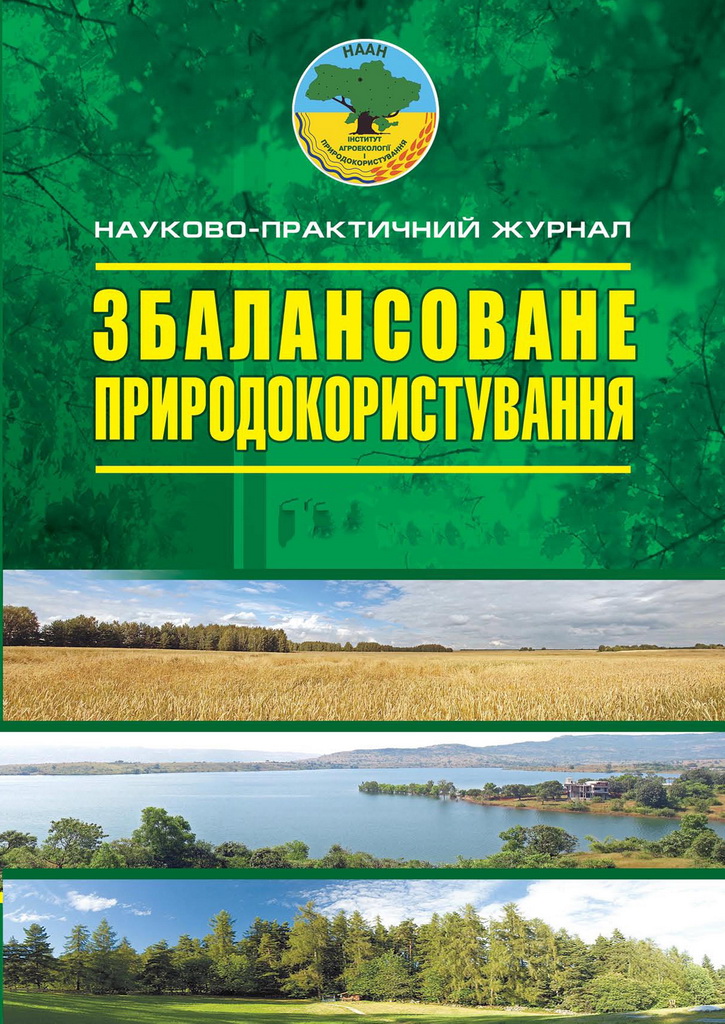ВИКОРИСТАННЯ ГЕОГРАФІЧНО ЗВАЖЕНОГО АНАЛІЗУ ГОЛОВНИХ КОМПОНЕНТ ДЛЯ АГРОЕКОЛОГІЧНОГО ЗОНУВАННЯ ТЕРИТОРІЇ УКРАЇНИ
DOI:
https://doi.org/10.33730/2310-4678.1.2019.170594Ключові слова:
урожайність, картопля, варіювання, динаміка, тренд, географічно зважений аналіз головних компонент, агроекологічне зонуванняАнотація
Агроекологічне районування є одним з найважливіших напрямів планування розвитку сільсько- го господарства. Тому метою роботи було вивчення можливостей агроекологічного районування території України за допомогою географічно зваженого аналізу головних компонент (GWPCA). Важливою особливістю географічно зваженого аналізу головних компонент є те, що на його основі можна побудувати карти просторової неоднорідності даних у процесі агроекологічного зонування території. Основою для агроекологічного районування було обрано показник врожайності карто- плі на території 10 областей (206 районів) поліської та лісостепової зон України. Глобальний аналіз головних компонент надав змогу встановити 3 головні компоненти, які разом пояснюють 43,1% загальної варіабельності простору ознак. Географічно зважений аналіз головних компонент дає змогу дослідити локальні патерни у динаміці врожайності картоплі, що характеризуються більшою пояснювальною здатністю, ніж тотальна модель. Найпоширеніший прийом GWPCA — картографування «виграшних» змінних не є придатним у разі аналізу часових рядів. Тому на основі наближених типів локальної динаміки нами встановлено кластери для кожної головної компоненти і застосовано саме картографування цих кластерів, замість відображення «виграшних» змінних. Географічно зважений аналіз головних компонент продемонстрував просторову не стаціонарність екологічних режимів, які визначають варіабельну складову врожайності картоплі у часі. Простори, у межах яких структура екологічних взаємодій залишається незмінною, можна розглядати як основу агроекологічного районування територій.
Посилання
Zhukov, O.V. & Ponomarenko, S. V. (2018). Prostorovo-chasova dynamika urozhajnosti zernovyh ta zernobobovyh kultur u Poltavskij oblasti [Spatial-time dynamics of cereals of grain and grain crops in Poltava region]. Bulletin of Poltava State Agrarian Academy, 1, 55–62.
Zymaroieva, A.A. (2018). Osobly’vosti prostorovo-chasovogo trendu vrozhajnosti zernovy’x i zernobobovy’x kul’tur v polis’ky’j ta lisostepovij zonax ukrayiny’ [Features of the spatiotemporal trend of grain and grain legumes yields in forest and forest-prairie zone of Ukraine]. Bulletin of Poltava State Agrarian Academy, 3, 66–73. (in Ukr.).
Aggarwal, P.K. (1991). Agro-ecological zoning using crop growth simulation models: characterization of wheat environments of India. In: Proceedings of the International Symposium on Systems Approaches for Agricultural Development, 2–6 December 1991, Bangkok, Thailand.
Cattell, R.B. (1966). The scree test for the number of factors. Multivariate Behavioral Research, 1, 245–76.
FAO. (1976). A framework for land evaluation. Food and Agricultural Organisation, Soils Bulletin 32, Rome, Italy.
Harris, P., Brunsdon, C. & Charlton, M. (2011). Geographically Weighted Principal Components Analysis. International Journal of Geographical Information Science, 25 (10), 1717–1736.
Horn, J. L. (1965). A rationale and a test for the number of factors in factor analysis. Psychometrika, 30, 179–185.
Iqbal, J., Thomasson, J.A., Jenkins, J.N., Owens, P.R. & Whisler, F.D. (2005). Spatial variability analysis of soil physical properties of alluvial soils. Soil Science Society America journal, 69 (4), 1338–1350.
Kaiser, H.F. (1974). An Index of Factorial Simplicity. Psychometrika, 39 (1), 31–36.
Kukal, M.S. & Irmak, S. (2018). Climate-Driven Crop Yield and Yield Variability and Climate Change Impacts on the U.S. Great Plains Agricultural Production. Scientific Reports, 8, 34–50.
Patel, N.R. (2003). Remote sensing and GIS application in agro-ecological zoning. Satellite Remote Sensing and GIS Applications in Agricultural Meteorology. In: Proceedings of a Training Workshop (7–11 July), Dehra Dun, India, 213–233.
Suriadikusumah A. & Herdiansyah, D.G. (2014). Study on land resources based on agro-ecological zones in Bandung district, West Java — Indonesia. International Journal of Applied Science and Technology, 4 (4), 212–220.
##submission.downloads##
Номер
Розділ
Ліцензія
- Автори залишають за собою право на авторство своєї роботи та передають журналу право першої публікації цієї роботи на умовах ліцензії Creative Commons Attribution License, котра дозволяє іншим особам вільно розповсюджувати опубліковану роботу з обов'язковим посиланням на авторів оригінальної роботи та першу публікацію роботи у цьому журналі.
- Автори мають право укладати самостійні додаткові угоди щодо неексклюзивного розповсюдження роботи у тому вигляді, в якому вона була опублікована цим журналом (наприклад, розміщувати роботу в електронному сховищі установи або публікувати у складі монографії), за умови збереження посилання на першу публікацію роботи у цьому журналі.
- Політика журналу дозволяє і заохочує розміщення авторами в мережі Інтернет (наприклад, у сховищах установ або на особистих веб-сайтах) рукопису роботи, як до подання цього рукопису до редакції, так і під час його редакційного опрацювання, оскільки це сприяє виникненню продуктивної наукової дискусії та позитивно позначається на оперативності та динаміці цитування опублікованої роботи (див. The Effect of Open Access).


